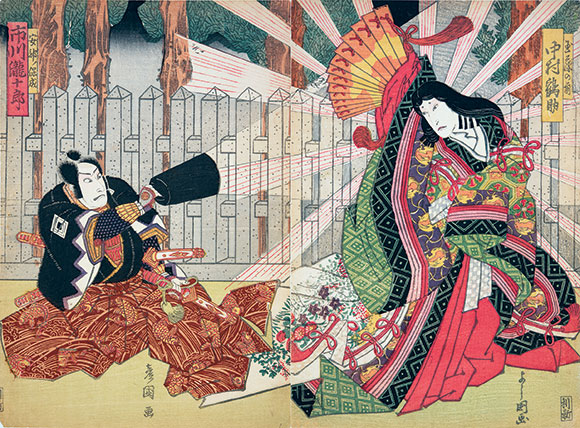

Gassaku (合作)
|
Gassaku (合作) were collective works — paintings, drawings, and prints on the same or related themes in a shared pictorial space by two or more artists. Some scholars limit the term to artists of comparable status; others use it a bit more generously and accept works by masters and students, or established artists and newcomers, as gassaku. In Kamigata (the Kyoto-Osaka region), ukiyo-e printmakers often engaged in shared enterprises as part of the participatory social, cultural, and creative mileu of the period (including poetry circles, dance performance, kabuki fan clubs, painting groups, and print "schools").
 |
| (R) Jukôdô Yoshikuni and (L) Ashikawa Hikokuni: (R)Nakamura Tsurusuke I (中村鶴助) as Tamamo no Mae (玉藻前) (L) Ichikawa Takijûrô I (市川滝十郎) as Abe no Yasunari (安倍泰成) Play: Tamamo no Mae asahi no tamoto (Sunlight on the sleeve of Tamamo no Mae: 玉藻前曦袂), 7/1823 |
Around 1821, Jukôdô Yoshikuni (壽好堂芳國), active c. 1813-32, began to modulate his forms and introduce a more curvilinear manner of depicting figures, as compared to the more rectilinear style of his earlier works that was also typical of prevailing actor portraiture in Kamigata from the early hosoban-format designs of the first decade of the nineteenth century to the early ôban-format sheets from around 1812 to 1818. By 1822–24, this "softer" style was increasingly more evident. A gassaku by Yoshikuni and Hikokuni (rignt and left sheets, respectively) from 7/1823 illustrates this point (see image above). Ashikawa Hikokuni (あし川彦國), active c. 1820-24, was a little-known member of Yoshikuni's Jukôdô (壽好堂) print and poetry circle; however, his art name suggests a possible connection with Kyôgadô [Gôgadô] Ashikuni (狂画堂芦國), active c. 1801-20. In the diptych shown above, both artists have adopted the manner of using slightly more proportional heads and faces, as well as less rigid costumes and poses. The two sheets by different artists work well together.
The play Tamamo no Mae asahi no tamoto (Sunlight on the sleeve of Tamamo no Mae: 玉藻前曦袂) was staged at the Ônishi Theater, Osaka. Nakamura Tsurusuke I (中村鶴助) performs the role of Tamamo no Mae (玉藻前) while Ichikawa Takijûrô I (市川滝十郎) is Abe no Yasunari (安倍泰成). The main theme involves Tamamo no Mae joining Prince Usugumo (the emperor's elder brother) in a plot to dethrone Emperor Toba and agreeing to use her supernatural powers to aid Usugumo. When the Emperor becomes ill, the chief astrologer of the court, Abe no Seimei [Yasunari], discovers — thanks to a gust of wind blowing out all the candles and lamps in the palace — that in the absence of illumination Lady Tamamo emits light from her body. He is convinced that she is a fox-witch whose pernicious magical powers have afflicted the emperor. He sets a trap by inviting her to a prayer service to save the emperor, where he unsheathes a magical sword and threatens to slay her. She is forced to admit her true identity, but then assumes her fox form — a spectacular, nine-tailed, white fox — and flies away, with Yasunari in pursuit. During her escape Tamamo no Mae transforms herself repeatedly (a country girl, a masseur, a god of thunder, a man, a street girl, a courtesan, and once again Lady Tamamo). At the moment illustrated here, Yasunari shines his lantern upon her as beams of light emanate from her body. She holds a folding fan (ôgi) whose open blades echo the beams of her supernatural illumination.
 |
| Utagawa Kunisada I (figures) and Utagawa Hiroshige I (landscape) Fûryû Genji — Akashi (Fashionable Genji — Akashi: 風流けんし明石), 4/1853 |
Gassaku were also popular in Edo. Among the most frequently encountered designs from that city were those shared by Utagawa Kunisada I and Utagawa Hiroshige I (and later, with Hiroshige II). Kunisada would draw the figures, such as actors or beautiful women, while Hiroshige I or II would provide the landscapes. The example shown below is a triptych titled Fûryû Genji — Akashi (Fashionable Genji — Akashi: 風流けんし明石 which could be written alternatively as 風流源氏明石), published in 4/1853 by Iseya Kanekichi (伊勢屋兼吉 whose seal reads "Kichi, Isekane": 吉 伊勢兼), with the blocks carved by Yokogawa Takejirō (横川彫竹). Two elegantly attired women on a balcony catch sight of Ashikaga Mitsuuji walking through the reeds at Akashi Bay. The story related to this scene was taken from an Edo-period reworking (and spoofing) of the original Genji monogatari (Tale of Genji: 源氏物語) by Murasaki Shikibu (11th century). Nise Murasaki Inaka Genji (A rustic Genji by a false Murasaki) was written by Ryūtei Tanehiko (柳亭種彦 1783–1842) with illustrations by Utagawa Kunisada, was published as popular, multi-volume illustrated novels called gôkan ("combined volumes": 合卷) by Senkakudô in 38 serial installments between 1829 and 1842. The story loosely mirrors Lady Murasaki's classic tale, but transposes the story into the floating world of Edo. The hero is no longer Genji, the imperial prince, but Mitsuuji, a popular playboy. Parallel to the original tale, the story follows the romantic exploits of Mitsuuji, but the correspondence to the original story varies widely. Resetting a classic tale within a modern context was a very popular literary and artistic genre during the Edo period called mitate (analog or comparison: 見立) that linked the contemporary with the historical, or the vulgar with the refined. Hiroshige later revised his landscape design for a triptych depicting Kanazawa Bay in Buyô Kanazawa hasshô yakei (Evening view of the eight famous sites at Kanazawa in Musashi province: 武陽金沢八勝夜景) from 1857; for another design from that series, see Hiroshige I. ©1999-2019 by John Fiorillo
For more works by Yoshikuni, see Yoshikuni.
For more works by Hiroshige, see Hiroshige I, Meiji Recuts, Mutamagawa, and Woodgrain.
BIBLIOGRAPHY
- Forrer, Matthi (with essays by Suzuki Jûzô and Henry D. Smith II): Hiroshige Prints and Drawings. Munich and New York: Prestel Verlag, 1997
- Matsudaira, Susumu: Kamigata yakusha-e shûsei (Collection of Kamigata actor prints), Vol. I. Osaka: Ikeda Bunko, 1997.
- Schwaab, Dean: Osaka Prints. New York: Rizzoli, 1989, no. 66.
Viewing Japanese Prints |